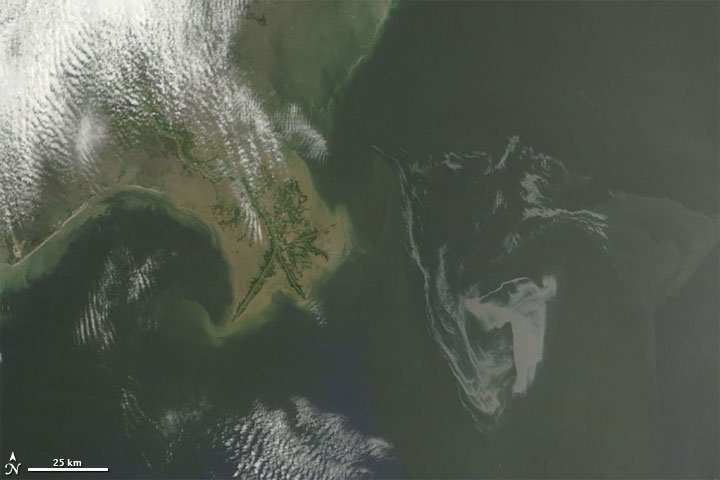Emeritus Professor Jerome (Jerry) Milgram has researched the science of oil spills on the ocean surface and in deep water wells since 1970. He has overseen the containment of ruptured wells in the Gulf of Mexico and holds many patents for ameliorating, containing and collecting ocean spills. In a recent phone interview with Jordan Lewis of the Department of Mechanical Engineering, Milgram discussed current efforts to contain the widening oil spill off the Louisiana coast.
Q. What are the possible measures for stopping the flow of oil from a ruptured underwater well?
A. To stop the flow, the engineers would like to quickly drill a relief well. This would involve a separate well drilled in a strategic location into the reservoir formation. Once the well is functioning, a series of quick, high-pressure steps are followed to “kill” the well. First, salt water is pumped into the reservoir, followed by mud and finally concrete. The mud and concrete will seal the space between the oil-bearing formation and the sea bottom if the process is successful. What is unique about the presently leaking well is that it is in very deep water in the range of 5,000 feet. This depth will increase the complexity and overall time required to complete necessary steps.
Q. The engineers have attempted to use a cone shape “cap” to cover the well and control the flow. Are you familiar with this technique and will it be effective?
A. I was involved in using a “cap” in 1979 to control the IXTOC oil well blowout in the Gulf of Mexico, roughly 50 kilometers north from Ciudad del Carmen, Mexico. I had flow- and pressure-measuring equipment on the device. In that incident, there was a large rupture on the seafloor and the spill into the Gulf was massive. The mitigation crews from the oil company lowered a large, concrete, conical shaped “funnel” onto the ruptured well-head to try to control the flow out of the well. In this case, the water depth was about 200 feet deep, much shallower than the recent blowout. In each case the oil and natural gas bearing formation was thousands of feet beneath the seabed.
Once the cap or containment dome was “placed,” there were several issues that affected the operation. First, the cap bottom was somewhat elevated above the ocean floor and the gap allowed for excessive water to enter the system and for excessive oil and gas to escape from it. Other problems included lack of a large ship into which the collect oil and water could be pumped.
Q. The first containment cap used to cover the ruptured well was unsuccessful due to the problems underneath the submerged cap. Can you explain what happened and if this can be avoided?
A. When methane, a major component of natural gas, and water are present at low temperature and high pressure, they combine to form solid crystals. Each hydrate crystal is made up of a cage of water molecules filled with a variable number of methane molecules. New oil wells often release a considerable amount of natural gas along with the oil. The hydrates form groups that appear like snowflakes and have an ice-like consistency when their concentration in the water is low. With high concentrations of hydrates in the water, the result has a consistency of snow-ice-water slush. The slush is known to be rigid enough to clog pipelines in some circumstances.
In the case of the first attempted containment cap, the concentration of gas hydrate clogged either the hole at the top of cap, or a short section of pipe that was attached to the top of the cap. In a normally functioning oil riser, the hydrates would decompose into natural gas and water in the upper part of the riser where the pressure is lower. This would form a powerful gas-lift pump. I am not in a position to say if such a system could work effectively with a very large amount of gas hydrate entering at the bottom of the riser, seeping in from under the cap.
Q. We see in the news that oil is making landfall and the inflatable booms are often shown awash on the beaches. How effective are the inflatable booms at corralling the oil?
A. Inflatable booms are capable of slowing the spread of oil and concentrating the spill within the arc of their reach. Under appropriate circumstances, use of booms increases evaporation of the lighter fractions of the oil before the slick comes ashore. To be most effective, the booms need to work in connection with a skimming mechanism to retrieve the oil sitting on top of the water. This is often done with a barge or tanker that has plumbing capable of recovering and holding the oil/water mix as it is removed from the ocean’s surface. Booms are not perfect. The motion of the waves allows for some amount of oil to seep beneath the boom and bypass the containment system — that is inevitable. The ideal boom would have the oil-skimming ability built into them, but the cost of booms with such a capability is significantly greater than that of commonly used booms.
Q. Planes have been dropping a chemical dispersant onto the oil slicks. Is it better to disperse the oil or attempt to corral the oil? These two ideas tend to compete with one another.
A. Dispersants have benefits. In theory, they break up the clumps within the oil sheen and increase the surface area of the oil. With greater surface area, small oil-dispersant water droplets can be distributed throughout the water column allowing for a higher rate of bacterial degradation and evaporation of the oil. Both of these processes — evaporation and bacterial decomposition — occur naturally, and that is what is being encouraged. Unfortunately, these are slow-acting processes, and they depend heavily on the oil composition, sunlight, movement of the waves and other factors. Again, with the movement of the waves, this is good for mixing the dispersants but troublesome for the booms attempting to contain the oil. Additionally, we are not very familiar with the negative implications of adding 100,000-plus gallons of dispersants into the ocean. The environmental impact is not fully understood at this time.
Q. Some critics would claim that the response to the recent spill has been slow or ineffective. How would you respond to that?
A. Preparing for an event of this magnitude is nearly impossible. Maintaining a stand-by crew of specialists that would respond to a ruptured well is just not going to be realistic. The time between incidents and the cost of the specialized equipment/training is far too great to just have waiting around. Also, it is important to note that the circumstances for all ruptured wells are very different. From what I’ve seen and read in the news, the response so far has been addressing the problem. What I have not seen in the media are any tankers or barges filled with oil that has been skimmed from the surface. Ideally, oil from the slicks would be captured and brought to shore for processing.
Q. Can the oil from the spill be used after it has been mixed with salt water?
A. Yes, there are still many uses for the oil but in most cases all the water and salt must be removed from it — a difficult, expensive and time-consuming task in view of the large quantity of material. With the quantities of oil present in the Gulf, tremendous storage capacity would be required to hold the oil/water mixture before it could be processed. I am not sure if there is a facility in the United States capable of the task. A refinery that has this oil/water separation capability is something worthy of consideration for future responses.
As the oil spill off the Louisiana coast widens, the mechanical engineering emeritus professor discusses floating booms, containment caps and more
Publication Date:

Caption:
The oil slick as seen from space by NASA's Terra satellite on May 1.
Credits:
Image: NASA

Caption:
Department of Mechanical Engineering Emeritus Professor Jerome (Jerry) Milgram
Credits:
Photo: MIT Museum





